
|
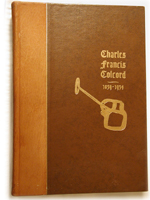 |
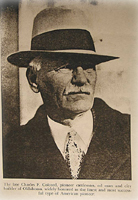
|
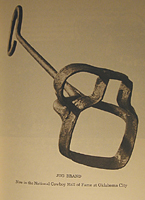 |
|
Charles Francis Colcord, my great-grandfather, was a pioneer of the old west, and an old-fashioned American hero.
|
|
He was born in Kentucky in 1859, and for much of his young childhood his father was away fighting for the Confederacy in the Civil War. After contracting malaria near New Orleans his father moved him to the ranch of a friend near Corpus Christi, Texas so that he could recover. When he was 12, his family planned to return him to New Orleans, so he ran away. Taking his six-guns and his horse, he could ride, rope and shoot well enough to get a job as a cow puncher on the Abilene trail, moving thousands of head of cattle from Texas through the Indian Territories to Abilene, Kansas, the nearest railhead, where they would be shipped back to the East Coast. He built up his own herds and his brand, the Jug brand, became famous throughout Kansas and Oklahoma. He then worked as a range detective, and gained a reputation as a lawman. In 1889 the cattle market collapsed, and the Oklahoma land run was announced. On April 22, 1889 Charley made the run, arriving in Oklahoma City that day and trading his team, wagon and gear for a shack and lot that became Lot Number 1, Block Number 1, Oklahoma City.
|
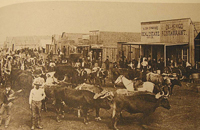 |

|
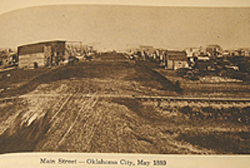 |
| Oklahoma City, 1889 |
Charley and Bill Tilghman
|
Main Street 1889 |
As Oklahoma boomed he served as chief of police, then Oklahoma City's first sheriff (essentially the army left what was a territory, declared it a state, and gave Charley the stockade and a gun.) He later became a US Marshall (appointed by President Grover Cleveland), serving with Bill Tilghman. He worked hard to control a lawless, wild area, fighting with the Bill Doolin Gang, Tulsa Jack, the Dalton Gang, Little Dick West, and others. He personally rounded up five members of the Dalton Gang and supervised their hanging.
He also made the Cherokee Strip run and built a home there. During the run his horse ran into the horse of an old friend, Sheriff George Parker of Lincoln county, when George's mount stepped into a prairie dog hole. George said “Stay down, Charlie, that's a corner lot!” and Charlie staked his claim where he fell. In six hours Perry, Oklahoma had a population of 15,000.
He assisted in the discovery of the Glen oil pool, and with his profits built the Colcord building in 1912, then the tallest building in Oklahoma City. It was the first steel-reinforced concrete building built in Oklahoma, because Charley had seen the devastation to less-strong buildings in San Francisco. The only buildings standing after the fire and earthquake there were the steel-reinforced concrete buildings, so that's what he built. The Colcord building still stands, and is occupied and in daily use. He also built the Commerce Exchange Building and the Biltmore Hotel. When he died the city named the Civic Center after him. His dedication to the city and his humble origins landed him in the Cowboy Hall of Fame. He also built one of the first large private homes in Oklahoma City, starting neighborhoods that still stand today.
|
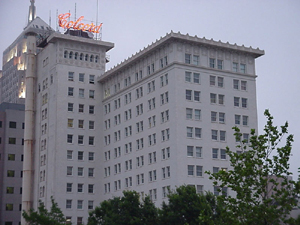 |
 |
 |
|
Colcord Building at Dusk
|
Marble Lobby
|
Elevator Doors
|
|
|
|
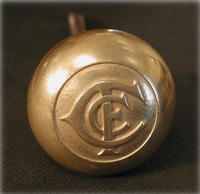
|
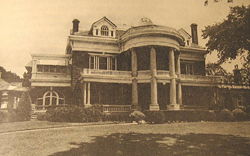 |
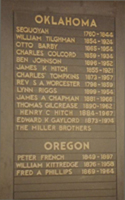
|
|
Solid Brass Doorknob, engraved with "CFC"
|
Colcord Mansion in Oklahoma City - 1903
|
Oklahoma Hall of Fame
|
His last episode with lawbreakers occurred in 1933. A close friend of his, Charles Urschel, was kidnapped by Machine Gun Kelly and his gang and held for ransom, not uncommon in those Depression days. Charley called a meeting at the Colcord building of the richest men in Oklahoma City and put together a large reward. Even at age 74, I'm sure he would have preferred to strap on his old .44’s, but times had changed. Kelly was eventually captured, and Charles Urschel returned unharmed.
Charley was one of the most famous Oklahomans, even to the point of being lionized in pulp magazines like Golden West as “CHUCK COLCORD, SCOURGE OF THE CATTLE RUSTLERS.” We'll never know if he was more embarrassed by being called “Chuck” or by the overheated prose, like... “Your rep sheet sez you're a hell on wheels with shootin’ irons as well as rustler bustin’.” How the “reporter” got verbatim conversation down from 1881 isn't clear.
.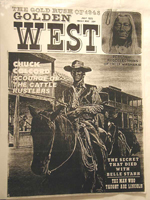
What is clear is that Charley’s life encompassed the Civil War, the land rushes, the Wright Brothers flight, World War 1, Charles Lindbergh, the Roaring Twenties, the Depression, and the transition of Oklahoma City from a prairie with scattered teepees and herds of bison to a booming metropolis with skyscrapers, oil fields and interstate highways. A cattle drive from Corpus Christi to Abilene might have taken two to three months in the 1880’s. In 1934 you could drive it in three or four days. There were few lawyers, and fewer judges. Your word was what you depended on for daily business, and many of Charley's deals were done with handshakes. He died in Oklahoma City in 1934, and an era of pioneers and heroes died a little bit with him.
|
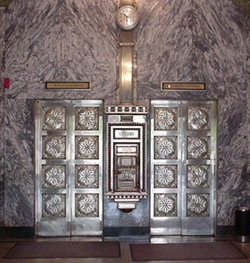
|
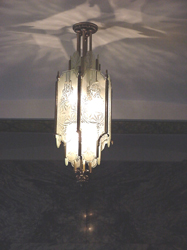
|
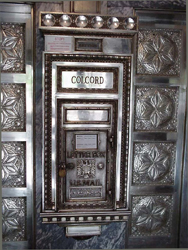
|
|
Main Lobby Elevators
|
Lobby Chandelier
|
Mailbox
|
|
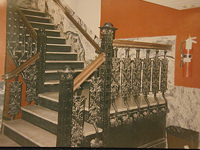 |
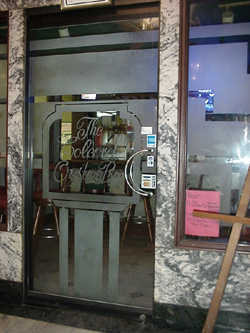
|
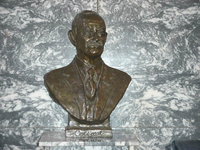 |
|
Iron Lobby Balustrade
|
Colcord Oyster Bar (former barber shop)
|
Bust in Lobby
|
|
|
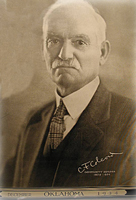
|
|
|
Oklahoma Magazine Dec. 1934
|
|